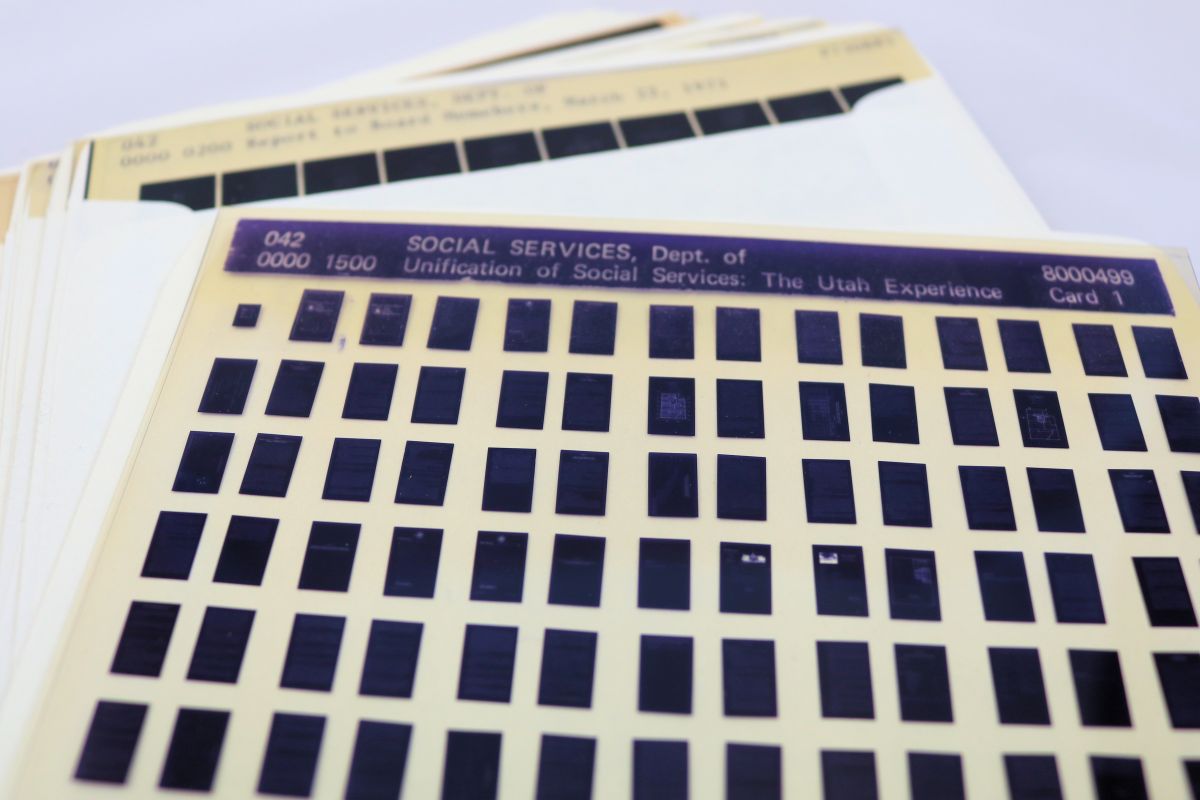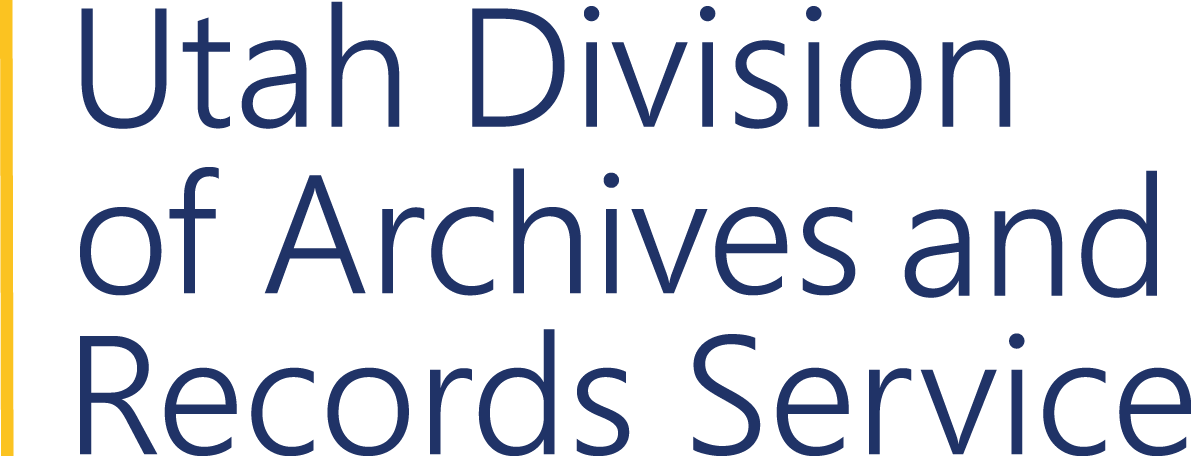Microfiche
Introduction
Microfiche, or “fiche”, from the French word fiche meaning a small card, are made from 105 mm film divided into cards protected by an acid free sleeve. Each fiche contains multiple micro images in a grid pattern. Reduced 24 times (24X), 98 pages can be put on one fiche. At 48X, 270 pages will fit. Documents may be exposed on microfiche in a variety of styles. Identification information placed at the top of the fiche in a title area can be easily read without magnification. Microfiche are somewhat easier to handle and information can be found quickly. They allow additions more easily than microfilm because extra fiche can be filed behind the first, keeping data intact.
Fiche, not just a town in Ethiopia, is held in the Archives in master or diazo format. Diazo refers to the diazonium salts used in the coating layer. The salts are combined with dyes to produce the image. Diazos often look blue or brown. Most user copies are in diazo format. Reproductive quality can be as high as the original. If the original microfiche has good color (while Archives generally only holds black and white fiche, there are a few photographs in color), fiche reproduction is easier to control than traditional printer’s inks.
The post-World War II era saw fiche used commercially for bankers, auto mechanics, salesmen, medical researchers and art librarians. Microfiche was used in the Utah State Archives starting 1975 as it was used to provide access to original and unpublished scholarship and documents. Reported holdings in microfiche grew exponentially until 1990. The format was deemed valuable for preservation, not only because it is harder to tear a microfiche card than to rip a page from a book, but the film has a 500 year life expectancy when handled, processed and stored properly.
In the 1970’s, microfiche boasted of low production costs, longevity and allowing the ability to hold more publications that previously possible. With a microfiche reader, images can be made larger than the original for easier visibility. Jacketed film is often used synonymously with microfiche. This format boasted of the ease and cheap way to correct for proof or new editions as frames could be cut in our out, and the time required for such production was short. Fiche readers were also seen as easier to handle than film readers. Libraries found microfiche attractive when important books were loaned in fiche and the book stayed safely on the shelf. Some university libraries even allowed the microfiche to be purchased.
Microfiche is less common now due to the rise and ease of digital formats. Despite the cost effectiveness of microfiche in the 1970’s, by the turn of the century space constraints and manpower was a concern. The risk of a card being misfiled was considered too great. Today’s electronic records, such as electronic signatures and metadata, are not easily stored or reproduced on paper, let alone microfiche. The change to electronic storage in records management allowed numerous users to access the same document. Fifteen minutes to process a search on microfiche is a long time in the digital world. Digital storage allows instant access.
The Utah State Archives collections have over 1,100 series with microfiche holdings. Over 300 of those series are microfiche only. The most recent microfiche sent to the Archives were created by the Division of Finance.
Microfiche is the only format for the following series:
| Bureau of Environmental Health | |
| Pesticide study reports | Series 14091 |
| Bureau of Communicable Disease Control | |
| CHESS study reports | Series 14093 |
| Division of Air Quality | |
| Air quality case files | Series 1724 |
| District Court (Third District- Salt Lake County) | |
| Satisfaction of judgment records | Series 5970 |
| Davis County (Utah). County Recorder | |
| Official Records | Series 7181 |
| National Guard | |
| Official military personnel files | Series 6678 |
| Office of Legislative Research and General Counsel | |
| Bill files 1999-09 | Series 7073 |
| Division of Oil, Gas, and Mining | |
| Wells Records Program files | Series 8633 |
| Office of the State Auditor | |
| State agency audit reports | Series 1664 |
| School district audit and budget reports | Series 19997 |
| County financial reports | Series 3747 |
Sources
Weintrob, Harry. "Financial Information on Microfiche and Microfilm." Financial Analysts Journal 25.6 (1969): 17-19.
United States General Accounting Office. Electronic Dissemination of Government Publications. Mar. 2001.
Hipp, Bonnie. "UAMS Implemented ECM - Capture Expert Blog." AIIM - Your Information Management and Collaboration Resource.
Hipp, Bonnie. "University of Arkansas for Medical Sciences, Expediting Enterprise Information Flow with Electronic Records Storage - Capture Expert Blog." AIIM - Your Information Management and Collaboration Resource. 8 Sept. 2010.
Dukart, James R. "Records Management Emerges." AIIM - Your Information Management and Collaboration Resource. Oct. 2002.
De Mink, H. L. "Linnaeus on Microfiche." Taxon 7.3 (1958): 71-73.
Robbins, Eugenia S. "Microfiche - A Visual Explosion in Mini-Dimensions." Art Journal 37.1 (1977): 40-43. College Art Association. Web.
Shanmugasundaram, Murali. "Powerful Document Management." AIIM - Your Information Management and Collaboration Resource.
Gingrande, Arthur. "Introduction to Electronic Imaging." AIIM - Your Information Management and Collaboration Resource. Jan. 2003.
Fireman, Jerry. "A Stitch In Time." AIIM - Your Information Management and Collaboration Resource. Dec. 2000.
"Microfiche - Ohio History Central - A Product of the Ohio Historical Society." Ohio History Central - An Online Encyclopedia of Ohio History - Ohio Historical Society. 8 Jan. 2007.
 This research guide was written by Rebekkah H. Shaw in December 2011 under the National Historical Publications and Records Commission grant to the Utah State Archives and Records Services for the Utah Microfiche Backlog Project (Grant No.: NAR10-RB-50086-10).
This research guide was written by Rebekkah H. Shaw in December 2011 under the National Historical Publications and Records Commission grant to the Utah State Archives and Records Services for the Utah Microfiche Backlog Project (Grant No.: NAR10-RB-50086-10).

Page Last Updated May 21, 2012.
